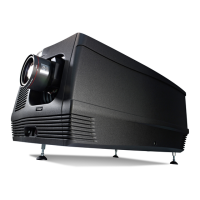4. Troubleshooting
Where :
•‘Time’ = the time w hen the e vent occurred
• ‘facility code’ = component lev el that generates a log me ssage
• ’severity code’ =theseveritycanbe:info–debug–warning–alert–err.
• ‘component name’ = component nam e that generates a log message.
- dp60 =mainprocess
- kernel = Linux kernel
- router = c omponen t w hich manages the router
- TI_marriage = com ponent w h ich handles the ma rriage
- clo = com ponent which handles Light S ensor logic
- license-manager = internal licens e manager
- crypto memory = process which handles comm unication with crypto memory module (ID card)
• ‘pid’ = Process identifier. The internal process identifier, of the com ponent generating the log mess age.
• ‘message’ = T he actual error message.
The Barco controller inserts every h our an unique entry in the Barco log file and in the TI log file. This is done to be able to sy nchronize
events in both log files, when the c locks are not aligned. It will also be used for a tool, that is still to be im plemented, that will mer ge
both log files, to make better analys is.
Example of such an entry :
Feb 3 02:41:16 localhost local0.info dp60[233]: log mark - 0000003c1b84 - 8
Each Barco entry into a TI log is proceeded with a B.
What does the id m eans (as in the example) :
• 0000003c
-thefirst 4 bytes give a hex interpretation of how many time the system has been booted.
- 3c hex is 6 0 in decima l. It means that this sy stem has been booted 60 times. Every boot cycle increases the timer with 1.
• 1b84 = the last two bytes, are random unique 2 by tes.
• 8 = the last digit indicates the number of hours passed in this boot cycle (in a decimal value). Ev ery boot cycle resets this
number to 0.
Ethernet connect ion messages in log file (some examples).
Apr 6 14:05:19 localhost local0.info dp60[233]: main - closing connection of
150.158.197.64:43680 (keep-alive time expired)
→ after 15 minutes of inactivity projector will close connection.
Apr 6 14:08:55 localhost local0.info dp60[233]: main - accepted connection from
150.158.192.133:43680
→ connection from communicator, from pc with ip addres s 15 0.158.192.133
Apr 6 14:08:58 localhost local0.info dp60[233]: log (port = 150.158.192.133:43680:1e) - lo-
gon-phmt-barco-default
→ communicator inserts in log file, who logged on to projector
Apr 6 14:09:07 localhost local0.info dp60[233]: command (port = 150.158.192.133:43680:1e) - set
lamp on
→ Command messages also indicate originator.
Apr 6 14:09:07 localhost local0.info dp60[233]: system - load fcb file "lamp-on“
→ on fan controller board, lamp-on state is set.
External co mman d s received by the Barco controller are preceded with the comm and (port = xxx) string
Where x xx can be :
• /dev/ttyS0:0 = C omm and comes from the serial connection labeled (“RS232 IN"). That can be from a touch panel which is
connected through a RS232 cable, or from a com munica tor which is connected se rially.
• /dev/ttyS2:0 = C om mand c omes from a touch panel attached with a dedicated c
able to the back of the projector (touch
panel input).
• /dev/ttyS3:0 = Com mand comes from the TI board. This is typically a comm and that is part of a macro stored on that board.
• 10.36.62.17:43680 = Command comes from a remote m achine with indicated IP address, followed by the local of the r emote
machine that send this comm and internal. The command is initiated internally, due to an internal reason.
• button = button is triggered from the keypad, attached to the projector.
Some examples :
R5905043 DP2K-12C/11CX 19/02/2018
75

